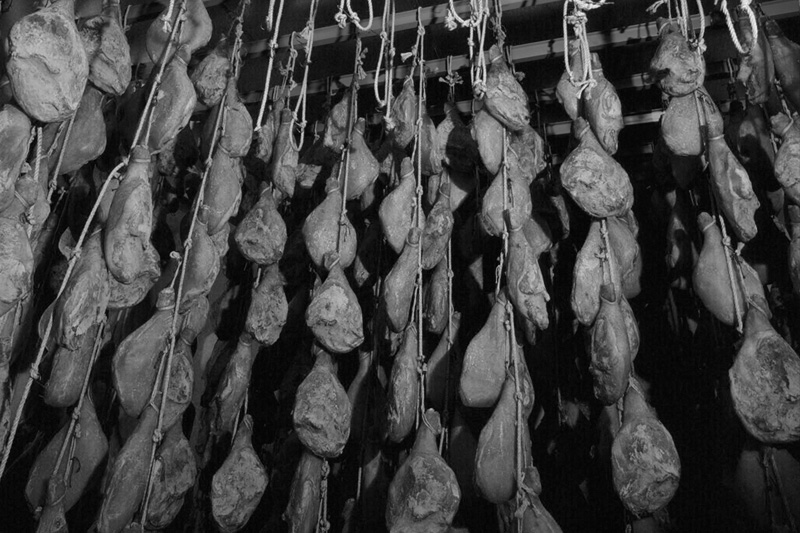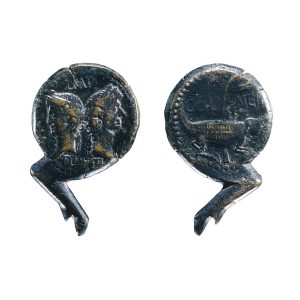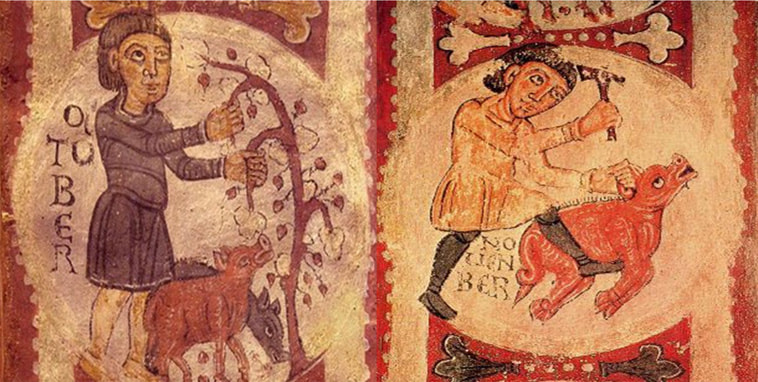
It is undeniable that ham is intimately linked to Spanish gastronomy and culture. Present in our homes, our bars, in our shops, at our weddings and celebrations, and even in our literature and cinema, ham is doubtlessly an emblem of “Brand Spain”. Beyond our borders, there is probably not a single bar or restaurant worthy of calling itself “Spanish cuisine” that does not serve ham on its menu. So, how long has this happy marriage lasted?
For the pre-Roman populations that lived on the Iberian Peninsula, such as the Celts, pigs were already part of their diet, even becoming a cult figure. Iberians also traded this animal as back then; it was kept entirely in salt to preserve it. There are theories that it was the Phoenicians, a trading people, who brought pigs to Spain through settlements such as Gadir (Cadiz) or Malaka (Malaga). The Phoenicians were way ahead of their time in the salting industry. Ruins still remain of some facilities intended for salting meat and fish close to Alicante and Larache (Morocco), as mentioned by Antonio Solé Ribas in his book “Estudio Monográfico sobre el jamón serrano. Fabricación controlada y estandarizada” (Study on Serrano Ham. Controlled and standardised manufacturing).
However it happened, there are documents prior to Roman times that bear witness to the existence of ham of the Iberian Peninsula.
A delicacy for the Romans
It was probably the arrival of the Romans to what they called Hispania when ham really acquired its status of delicacy. The first references to how it was made come from Roman times. Food Technology lecturer from the Department of Animal Production and Food Science, at the Cáceres Veterinary School, Jesús Ventanas Barroso, was recently published in JamónLovers, stating that Cato the Elder, Roman politician, writer and soldier, in the 3rd century BC, already mentioned that it was necessary to put the legs between layers of sea salt, without touching each other, for a period of 12 days.
Among the hams from the peninsula, particular prestige was awarded to ham from Pomeipoles (Pamplona) and Tarraco (Tarragona), where a fossilised ham has been discovered that is 2 thousand years old.
In Rome, sacrificing pigs was institutionalised. The slaughter was in principle reserved for a slave with privileges who acted as the cook – coquus – although, little by little, they were replaced by more specialised chefs known as vicarius supra cenas.
Ham was doubtlessly one of the most appreciated and commercialised products from the peninsula to all of the Roman Empire. This trading was so important that, during the period of emperors Augustus and Marcus Vipsanio Agripa, coins were minted in the shape of a ham.

Ham as an emblem of Christianity
It is no secret that pork consumption fell under Muslim rule. For almost 800 years, the Iberian Peninsula was inhabited by the Taifa Kingdoms, although they never controlled the whole land.
Not all natives converted to Islam, although they were generally obliged to convert to avoid heavy taxes and social stigma. It is estimated that at the end of the first century of their rule, only between 5 and 10% had converted. Around the 9th century, the percentage of converts increased to 50%. This percentage continued to grow gradually in zones controlled by the Muslims, which were shrinking little by little. During the Reconquest, the opposite effect was seen. Muslims and Jews were obliged to convert to Catholicism or be expelled.
From the 13th century onwards, the Inquisition began to persecute false converts. One way of publicly demonstrating “pure blood” to avoid persecution was to eat pork, as this was forbidden for both Jews and Muslims. Consequently, many homes hung hams in their windows to show that Christians lived there.
Since the Middle Ages…
Just like many other things, the monasteries and convents were in charge of preserving part of our culture’s gastro-legacy during medieval times. The monks used to keep pigs so that, after the slaughter, they could fill their larders.
The Reconquest’s southerly progress during the 12th and 13th centuries consolidated pig breeding. At the end of the latter century, farming expanded, and herds of semi-wild pigs could be spotted in oak and holm oak woodland.
Little by little, breeding and slaughtering began to extend among country people, and it became popular to make hams and cold meat products in all villages and hamlets throughout our land. This is proven by texts from the Archpriest of Hita in the 14th century, who mentioned the importance of ham in our culture and later writings by Quevedo, Lope de Vega or Cervantes, who in El Quijote, mentioned an afternoon meal that Sancho Panza shared with a group of foreigners featuring ham bones that needed to be ‘chewed never mind sucked’.

…To the present day
Antonio Solé states that “the history of the Meat Industry as such, in the modern sense of the term, can be said to have begun in the Napoleonic era, and this was due to commissions for semi-sterile products intended for the French Army”. According to Solé, in Spain “the first people to systematically study pork products were Gerónimo Darder and Juan Arderius” until the late 19th century.
However, it was during the 20th century that ham reached its greatest popularity. Work on pig genetics and progress in animal feed and in the actual industry means that ham continues to evolve, guaranteeing its place among the most highly valued products, not only in Spanish gastronomy but all around the world.


